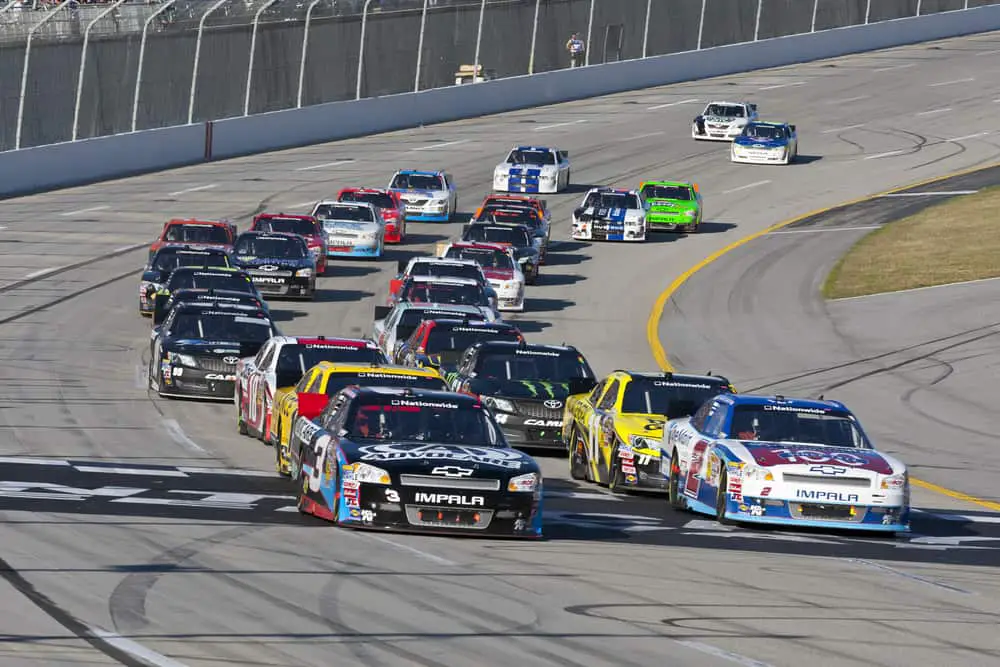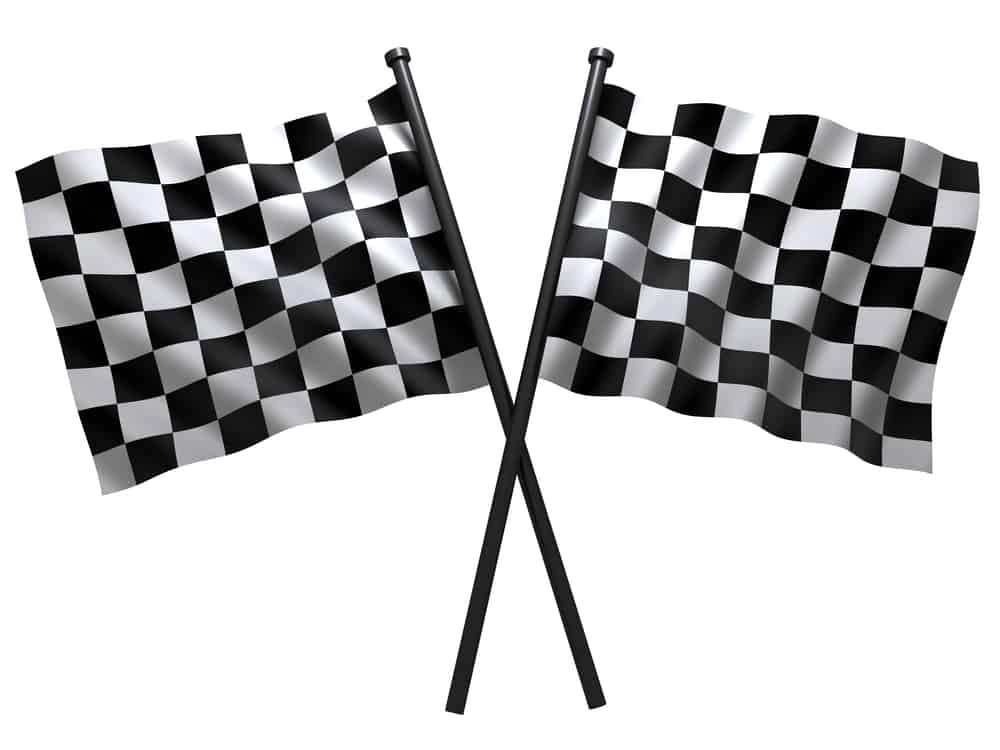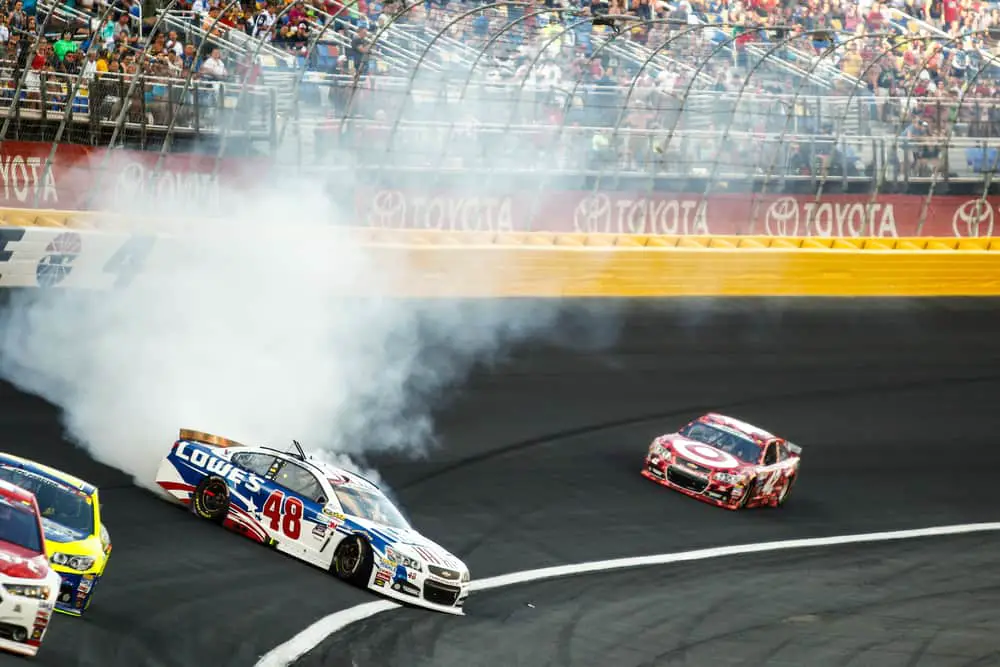NASCAR races are a thrilling spectacle for motorsports enthusiasts, packed with high-speed action and intense competition.
Depending on the specific series and event, the number of cars in a NASCAR race can vary. Generally speaking, the field consists of 36 to 43 cars in top-tier series events, such as the NASCAR Cup Series. Lower-tier series, like the Xfinity Series and the Camping World Truck Series, typically have a smaller number of entrants, ranging from around 32 to 40.
It’s important to note that these numbers can change based on factors such as race format, qualifying procedures, and track size.
For example, in special events like the annual All-Star Race, only a limited number of top-performing drivers are invited to participate.
The Basics of a NASCAR Race
Number of Cars in a Race
In a typical NASCAR race, the field consists of 40 cars competing for various positions along the race track.
Each team usually has multiple cars, with the number of cars entered being determined by the team owner. Every car bears the colors and branding of its sponsoring team.
Race Track Characteristics
NASCAR races take place on various types of tracks, from short ovals to superspeedways, each one presenting distinct challenges and requiring specific racing strategies.
The characteristics of a race track include:
- Length: The length of a NASCAR track can vary greatly. Short tracks are generally less than a mile in length, while superspeedways can be up to 2.5 miles long.
- Banking: Banked turns allow drivers to maintain high speeds in the corners. The degree of banking varies between tracks, with some having steep inclines in excess of 30 degrees.
- Surface: Tracks can have different surface compositions, such as asphalt or concrete. The grip levels and tire wear associated with these surfaces play significant roles in racing strategies.
Motorsports and Championships
Significance in NASCAR History
Motorsports have played a pivotal role in shaping the world of NASCAR. The organization has its roots in the early days of stock car racing, which evolved into the high-speed, competitive events we know today.
Championships have become an integral part of NASCAR, showcasing the talent and skill of drivers, teams, and manufacturers.
Throughout its history, NASCAR has hosted a variety of championships, ranging from regional to national levels. These championships have helped propel the sport to new heights and have become a source of pride for all those involved.
Competing in the championships requires perseverance, dedication, and teamwork, all key factors in the success of a NASCAR team.
Different Racing Series
NASCAR consists of multiple racing series, each with its own unique set of rules and regulations. The primary three national series include:
- NASCAR Cup Series: The premier series and most prestigious championship in NASCAR. The Cup Series attracts the best drivers, teams, and manufacturers in the world, making it the ultimate proving ground for racing talent.
- NASCAR Xfinity Series: A stepping stone for drivers looking to progress into the top-tier Cup Series. This junior championship allows up-and-coming racers to hone their skills and make a name for themselves on the national stage.
- NASCAR Camping World Truck Series: The only national series that features trucks instead of traditional stock cars. The Truck Series adds a unique element to NASCAR racing and attracts a dedicated fan base.
Racing Dynamics and Speed
Car Speeds during a Race
In NASCAR races, speeds can vary greatly depending on the track and conditions. On average, cars can reach speeds of 180 to 200 miles per hour during the race. At larger superspeedways like Daytona International Speedway and Talladega, cars have been known to surpass 200 miles per hour.
Some factors that can affect these speeds include:
- Track length and configuration
- Banking
- Weather conditions
It is worth noting that NASCAR imposes certain restrictions on the cars’ speeds to maintain safety. This is mainly achieved via restrictor plates which limit the amount of air and fuel mixture entering the engine.
Key Factors that Affect Speed
There are several key factors that can directly impact the speed of cars in a NASCAR race. Some of them include:
- Aerodynamics: The shape and design of the car play a vital role in reducing air resistance, drag, and downforce. With better aerodynamics, cars can reach higher speeds on the straightaways and maintain stability during turns.
- Horsepower: More horsepower leads to faster acceleration and higher top speeds. However, there is a trade-off with fuel efficiency, and drivers must carefully balance power output with fuel consumption during a race.
- Suspension: Proper suspension set-up can have a significant impact on a car’s handling and speed. Adjustments can be made to improve traction and cornering ability, ultimately affecting overall race speed.
- Tire Performance: Tires designed for optimal grip and durability can improve a car’s speed and handling. Tire wear and tire pressure adjustments during pit stops can also have a noticeable impact on race performance.
- Driver Skill: The ability of a driver to navigate and manage their car during a race can heavily influence a car’s speed and efficiency. Effective communication with the pit crew and strategic decision-making can make a considerable difference on the track.
Understanding Crashes in NASCAR
Causes of Crashes
Crashes in NASCAR races can happen for a variety of reasons. Some common causes include:
- Driver error: Mistakes made by the driver, such as misjudging distances or losing control of the car.
- Equipment failure: Mechanical issues with the car, like brake failure, tire blowouts, or engine problems, can lead to accidents.
- Weather: Rain, heavy winds, and other weather conditions can make the track slippery and difficult to navigate.
These factors can combine to create dangerous situations on the racetrack, resulting in crashes that sometimes involve multiple cars and last for hours.
Notable Crashes Through the Years
Over the years, there have been several crashes in NASCAR races that have gained attention due to their intensity or impact on the sport. Some of these crashes include:
- Dale Earnhardt’s fatal crash (2001): Motor racing legend Dale Earnhardt was killed in a crash during the final lap of the 2001 Daytona 500. His death led to a renewed focus on driver safety and the implementation of the HANS device, which is now mandatory for drivers.
- Carl Edwards’ airborne crash (2009): In the 2009 Aaron’s 499 at Talladega Superspeedway, Carl Edwards’ car went airborne and struck the catch fence, injuring several spectators. This incident led to safety improvements, such as the introduction of new catch fence designs and stronger materials.
- Austin Dillon’s last-lap crash (2015): During the final lap of the 2015 Coke Zero 400 at Daytona, Austin Dillon’s car was involved in a multi-car accident that sent his car into the catch fence, leaving it heavily damaged. Dillon walked away with only minor injuries, demonstrating the advances in safety measures that have been implemented in recent years.
Frequently Asked Questions
Backup Car Count
In NASCAR races, teams usually bring backup cars in case of accidents or mechanical issues.
The number of backup cars can vary, but generally, each team brings at least one backup car per driver to ensure their ability to continue racing.
Annual Race Number
During the NASCAR Cup Series, there are typically 36 points races held annually. Additionally, races like the All-Star Race and exhibitions can bring the total number of events to approximately 38.
Daytona 500 Cars
The Daytona 500, known as the Great American Race, is the premier NASCAR event. 40 cars participate in this race, which marks the beginning of the NASCAR Cup Series each year.
Reason For 40 Cars
NASCAR limits its races to a maximum of 40 cars to ensure optimal competition and safety for drivers and teams.
This number also contributes to maintaining the high standards of racing and providing an ideal show for viewers.
43 Car Races
There were instances in the past when NASCAR allowed 43 cars in a race.
However, since 2016, NASCAR has limited the number to 40 cars to improve the racing experience and promote closer competition among drivers.



